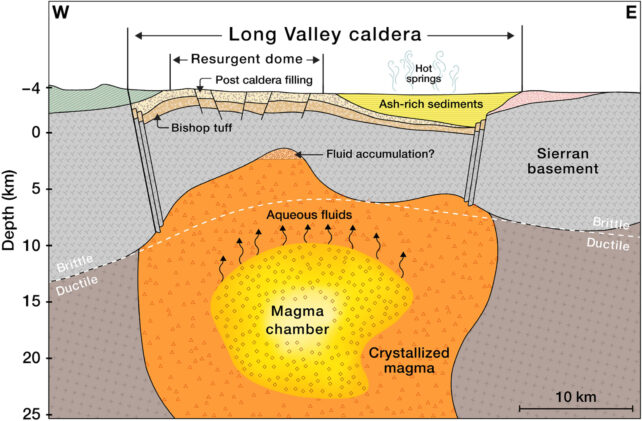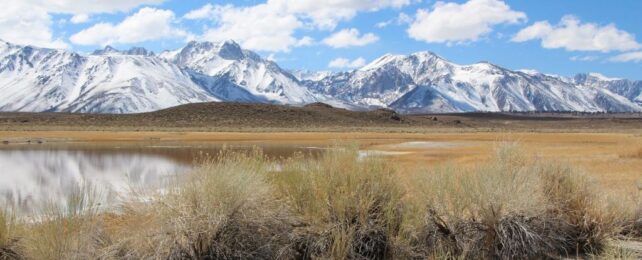A new study from researchers at the California Institute of Technology (CIT) suggests the Long Valley Caldera in eastern California is restlessly tossing and turning as its deep magma chamber cools down for a big, long sleep.
The last time the volcano blew was roughly 100,000 years ago. Long before that, it spewed up enough ash to bury the modern city of Los Angeles beneath a kilometer of sediment.
Today, the Long Valley volcano exists in a relatively sluggish state. But all is not quiet on California's eastern front. In the late 1970s, a swarm of earthquakes began to emanate from the caldera – a depression that sits atop the buried volcano.
For decades thereafter, the volcano produced regular periods of "pronounced unrest", which inflated and deflated the ground.
Thankfully, that isn't necessarily a sign of impending doom. Researchers at CIT have now found evidence that all this fussy activity is due to the supervolcano cooling down, not heating up.
"We don't think the region is gearing up for another supervolcanic eruption, but the cooling process may release enough gas and liquid to cause earthquakes and small eruptions," says geophysicist Zhongwen Zhan.
"For example, in May 1980, there were four magnitude 6 earthquakes in the region alone."
The team's findings are based on data collected from a 100-kilometer stretch of fiber optic cable, using distributed acoustic sensing.
Over the course of a year and a half, researchers at Caltech used this interconnected system – which is equivalent to 10,000 individual seismometers – to catalog more than 2,000 seismic events, many of which would not have been felt by humans on the ground.
This data was then plugged into a machine learning algorithm, which turned the measurements into a high-resolution map of the caldera and the volcano that lies beneath.
Ettore Biondi, a seismologist from Caltech and first author on the study, says this is the first time that a network of deeply distributed acoustic sensors has revealed Earth's interior dynamics.
The images produced are of "exceptional lateral resolution" in depths up to 8 kilometers, the team says. Even images of deeper portions, up to 30 kilometers down, were achieved with a "remarkable level of detail".
The findings show a definite separation between the large magma chamber of the volcano, sitting 12 kilometers below the surface, and the shallow hydrothermal system that sits above.
It seems that as the deeper chamber cools off, gasses and liquids bubble up toward the surface, possibly causing the quakes and inflated ground.

This boiling effect could "induce the observed surface deformation and seismicity," researchers write.
This is different and far less hazardous than what happens during an active volcanic eruption when magma in the chamber of the volcano forces itself up into the upper crust and out into the world.
The way seismic activity travels through these layers suggests the top of the magma chamber has a hardened lid of crystallized rock, which has cooled over time.
As the supervolcano's activity winds down, researchers say its "beating heart" is gradually slowing.
The team plans to measure those last beats at 20 kilometers deep with a 200-kilometer-long cable of seismic sensors.
The study was published in Science Advances.
